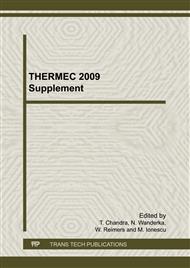p.598
p.604
p.609
p.615
p.621
p.627
p.633
p.639
p.645
Effects of Elastic Behaviour of Dies and Servo Press Machine on Deep Drawing Process
Abstract:
Characteristic features of elastic deformation of dies and presses during deep drawing were measured to examine the effects of elastic deformation of the press and dies on product accuracy. Strains were measured on the press including dies, a slide and a bolster of a servo press. A strain magnitude of 63 ×10-6 was obtained when the slide position was at the lowest point. Two slide motions of the servo press were selected to determine appropriate manufacturing conditions. An elastic deformation analysis of the die structure was then performed by CAD simulation. To find an appropriate die structure model, the vertical displacement of the die structure in the CAD simulation was compared to the experiment results. It was found that the vertical displacement of the die structure was 0.147 [mm] at the top surface of the die when considering elastic deformation of the die structure as well as the bolster of the servo press.
Info:
Periodical:
Pages:
621-626
Citation:
Online since:
January 2010
Authors:
Keywords:
Price:
Сopyright:
© 2010 Trans Tech Publications Ltd. All Rights Reserved
Share:
Citation:


